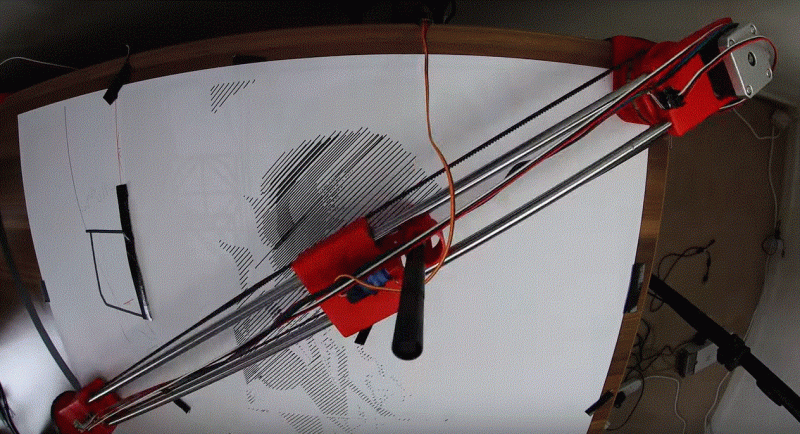To keep track of a location in a two-dimensional space, two measurements are needed. Most of the time, we would naturally think to do this by the Cartesian method, measuring position along one axis and then again along a second axis. But this isn’t the only way of keeping track of position. Polar coordinates, where the distance from the origin and an angle are used as the two measurements, works just as well, and sometimes can be a preferred method. This pen plotter tosses the expected Cartesian methodology we would typically expect in favor of this polar system.
The first prototype that [André] built was a good proof of concept. A pen attached to a movable carriage on a single rotating arm produced passable drawings, but as all prototypes go this one needed some refinement. Limit switches at the ends of the table, as well as within the arm, served to orient the plotter so that it didn’t manually need to be zeroed out every time. A linear actuator was added to give finer control over the pen’s pressure on the table, and finally an encoder was added to the base of the plotter to more accurately correct positional errors in the rotating arm mechanism.
With everything said and done, the polar coordinate plotter seems to work just as well as its Cartesian cousins might, orienting it like this has some advantages as well. Specifically, it is more adapted to drawing curves or circles than an X-Y device might be able to, like we saw with this similar sand-drawing plotter. Also, if allowed to rotate its entire 360-degree reach instead of just the 90 degrees shown in the video, a machine like this could theoretically reach a wider workspace more easily than other plotters.

















I have to say that I like this idea a lot. I wondered why no one tried to overcome the polarizing difficulty involved in part coordinates for a plotter. I am now inspired to investigate how to do it myself.
Place the arm drive and angle encoder at the center of the table mounted to a turnstile. Now plotting polar patterns is trivial in an anechoic test chamber. Measure microphone/speaker or RF antenna patterns.
As long as it is hovering with no base, due to sound being converted to mechanical vibration in solid objects. And the sound would also in theory be converted to mechanical vibration in the plotter equipment.
A polar plotter: A.K.A. an elbow. Don’t drag your palm, you’ll smear the ink!
It seems like it might be easier to have a fixed linear axis and stick the paper to a turntable.
These polar-based machines will always have an issue where the theoretical resolution and the realistic physical-world resolution are far apart from each other.
In one corner the resolution is way too course, in the other, the resolution is way too fine.
This ‘resolution gradient’ causes so many issues that it’s not worth trying to improve the quality. In the end it’s a lot easier to make a normal and less rigid, less precise machine with a normal cartesian setup with a separate X and Y axis that are positioned 90 degrees in relation to eachother.
Save yourself time that you can spend on a better pen lifting mechanism or a faster controller etc.
Agreed!
The article does say there is an encoder attached to the pen carrier, which could address the (severe) resolution problems associated with measuring the angle at the pivot. If you process coordinates in terms of radial and circumferential distance, the resolution is the same everywhere.
But that means changing how things work upstream, which is a bigger problem with exotic movement designs. It’s not just about whether it can be controlled, it also matters whether it works well with Illustrator or VCarve or whatever.
Still, this isn’t CommercialProductADay.com…
Encoder solves the position problem.
Resolution at the extremes is a different issue inherent to the design.
If you take the simple formula for the circumference 2*pi*r you’ll get that the resolution difference is r2/r1 where r1 is the distance from the pivot point to the minimum position and the r2 is from pivot point to maximum position.
So just eyeballing (and to make the math easier) if the pen can go between 3 and 21 inches from the pivot point on that arm you will have 7 times the difference.
So now let’s say your encoder resolution is very fine it will always be 7 times worse at the other end of the table.
Also I don’t think the encoder would be the problem but the motor because you will be sacrificing precision for speed.
Hey. Author here.
I think the issue with most polar plotters is that they have the rotation motor at the center of rotation.
I have the stepper motor at the edge turning the wheel which actually gives me a lot of resolution even when I’m far from the center.
Maybe I should do some tests to actually prove this, but I see no distortion in the drawings :)
Thanks for featuring my project here :D
Next up is going to be running the plotter remotely
Then doing some ascii art with it ^^
Strange plotters are awesome. :)